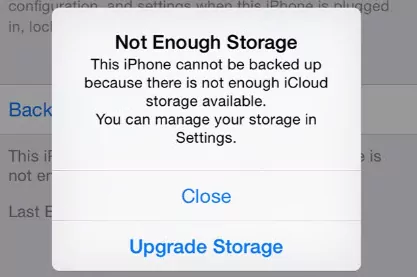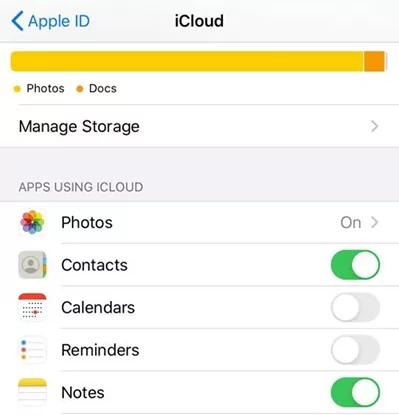iCloud is a central hub that stores and synchronizes every piece of information punched into an iOS device.
The technology ensures that all your information is accessible on multiple Apple devices.
The iCloud backup also helps you restore important data during data loss. Since iCloud holds all your treasures, managing it effectively is crucial if you rely on Apple devices.
Without proper management, iCloud storage can quickly fill up, leading to potential issues and additional costs.
If you, too, are getting an “iCloud Storage Full” message flashing on your screen, the strategies in this guide will help you effectively manage your iCloud storage and save costs on expensive upgrades.

Understanding iCloud Storage
iCloud is a cloud storage and synchronization service designed by Apple.
It allows users to store and access various data types, such as photos, videos, documents, contacts, and emails, across multiple iOS devices, including iPhone, iPad, iPod, and Mac.
Apple offers 5GB of limited storage to all its new users allowing them to store thousands of photos and hundreds of documents.
iCloud Backup, iCloud Drive, iCloud Mail, and iCloud Library are some of the essential elements of the iCloud storage service.
They hold all your photos, videos, documents, and data from third-party apps. Considering the list of items, the 5GB of free storage may soon reach its limit.
iCloud storage might become full if users accumulate a large amount of data, such as a large photo or video library, multiple email accounts with large attachments, or multiple document files.
Additionally, if users have multiple devices linked to the same iCloud account and they all synchronize data, it can contribute to the storage getting filled up.

How to Manage iCloud Storage
With full storage, you might be tempted to upgrade to an iCloud storage plan. But you can free up a lot of space by simply decluttering the unnecessary stuff feeding on your iCloud memory.
Here are a few tips on how to effectively manage your iCloud storage.
- Check Your Cloud Storage
Before you delete all your stuff out of frustration, checking which files and apps occupy space in your account is best.
Go to Settings > Navigate to iCloud > select Manage iCloud storage.
The top bar shows you the types of files in the limited iCloud space.
Continue scrolling to discover the list of installed apps and the corresponding amount of iCloud storage utilized by each.
Now you have a fair idea about all the space-consuming apps available on your device.
- Disable Unnecessary Backups
Backups are also a primary culprit behind fully occupied iCloud storage.
Many apps are configured to back up to iCloud upon installation automatically.
Disabling backups for unnecessary apps can also clear considerable space on your iCloud.
- Delete Old Messages And Attachments
It’s true that messages and chats only consume a few kilobytes of space.
But if you have been sharing hundreds of photos, emojis, and files with your friends and colleagues, then iCloud storage is bound to get filled quickly.
Similarly, email attachments also take up a lot of storage space on the cloud.
Deleting old conversations and unwanted emails can free up a lot of space on iCloud.
- Empty The iCloud Library
One of the primary causes of iCloud storage filling up is the abundance of photos.
By default, iCloud automatically backs up all the images you capture, ensuring their availability across all your devices.
Suppose you store older photos and transfer them to an external hard drive.
Transferring these photos to external storage lets you remove them from your iCloud account, freeing up valuable space.
Moreover, go through your photo library and delete duplicate images, which can consume unnecessary storage capacity. This process will help you optimize your iCloud storage.
- Clear Your iCloud Drive
iCloud Drive stores all your documents, PDFs, and application files.
Most iCloud users do not have many files stored in iCloud Drive. However, if you frequently save files on your devices, you will find that they consume space in iCloud Drive.
To manage your iCloud storage effectively, it is advisable to inspect your iCloud Drive for any stored files and delete them if necessary.
Doing so allows you to create additional space and optimize your iCloud storage.

Clearing iCloud Storage
Cleaning and deleting the folders mentioned above will create a lot of space on the cloud.
Here are quick steps to clear all the cramped folders on your iCloud account.
How To Delete Unnecessary Files And Backups?
Once you have a list of installed apps on your iCloud account, follow these steps to remove unwanted apps from the cloud storage.
- Go to the app you want to delete or remove from the cloud backup.
- Move the corresponding toggle to the right, and the app will be instantly removed from cloud storage.
You can also remove old backups from devices you no longer use through the following steps.
- Open iCloud from the Settings app (iOS) or System Preferences app (MacOS).
- Tap on Manage Backups > Delete Backpack.
- Click on “Delete Backup” again for confirmation.
How To Delete Old Messages?
- Open the Messages app on your device.
- Click and swipe the message thread that you want to delete.
- Click on the Trash icon to delete the entire conversation.
Note: Alternatively, you can only delete large attachments in your iChat. Tap the contact’s name > Click on the “Info” button > Select files > Delete.
How To Delete Emails And Attachments?
- Open iCloud emails.
- Select View.
- Click on Sort By Attachments.
- Select emails having large file attachments.
- Delete the selected files altogether.
How To Delete Photos?
- Go to iCloud and click on Photos.
- Select all the photos you no longer need. Click on the Delete option to remove access data from the cloud storage.
Apple doesn’t permanently delete photos and keeps them in the Recently Deleted folder. So, go to Photos > Tap on Albums > Recently Deleted > Select > Delete All.
However, if you don’t want to delete all your photos but still need extra space, use My Photo Stream.
My Photo Stream is another Apple cloud storage tool for storing pictures and videos. However, unlike My Photo Library, it does not use iCloud.
To save photos on My Photo Stream, follow these steps:
- Go to Photos.
- Turn off the toggle next to the “iCloud Photo Library option.”
- Enable the “Upload to my Photo Stream” option.
How To Cancel iCloud Storage?
If you have an iCloud subscription plan under your name, but now there is enough extra space on your iPhone, you can easily cancel your iCloud plan using these steps:
- Open Settings app
- Tap on your name > click on iCloud.
- Go to Manage Account Storage.
- Choose “Change Storage Plan”
- Click “Downgrade options” in the window’s bottom right corner.
- Sign in with your Apple ID and password.
- Click on the 5GB free storage plan and confirm.
Conclusion
iCloud storage subscriptions should be considered a last resort when your iCloud storage is nearing its limit or already full.
Instead, it is advisable to assess the current usage of iCloud storage and effectively manage it using the provided solutions from your iPhone.


